Page 369 of 750
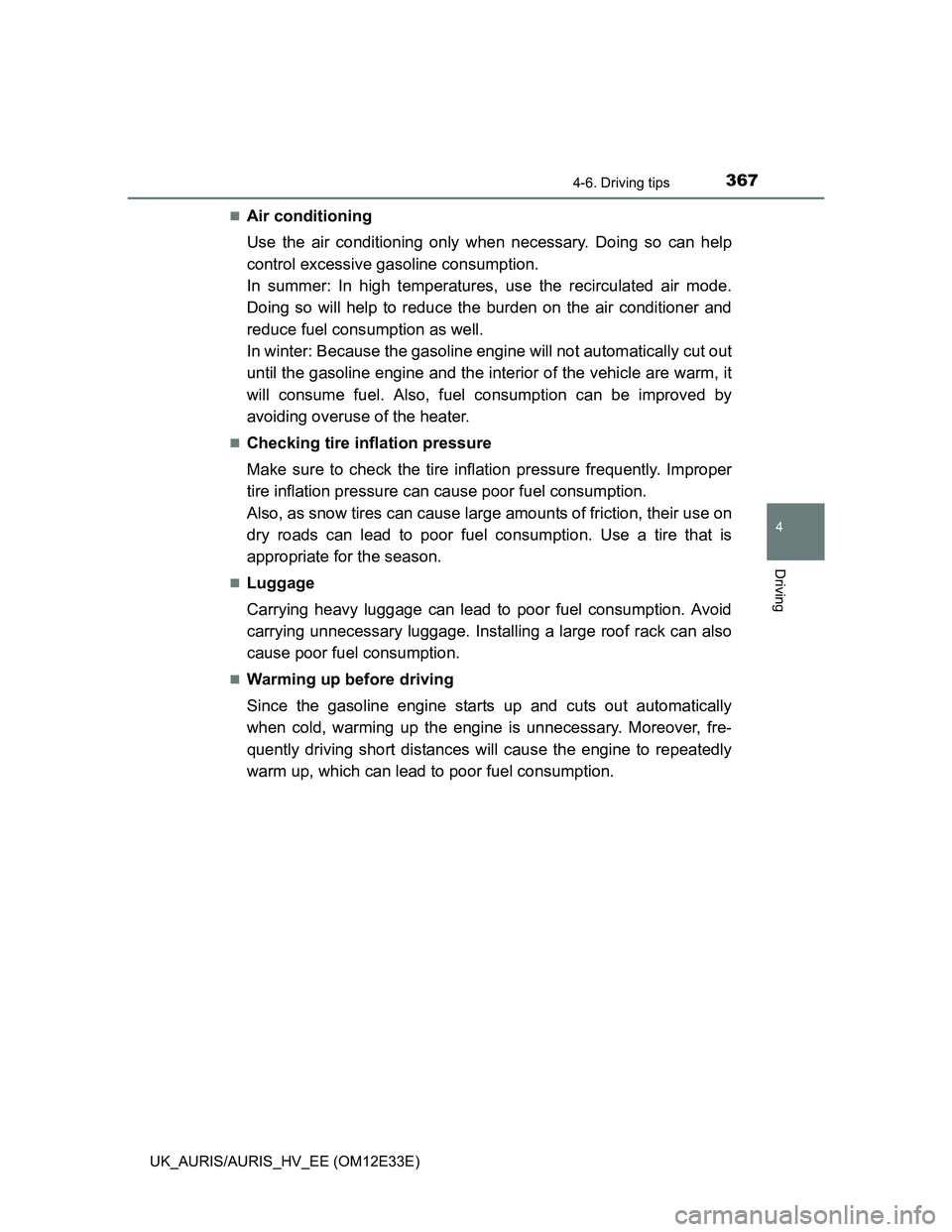
3674-6. Driving tips
UK_AURIS/AURIS_HV_EE (OM12E33E)
4
Driving
Air conditioning
Use the air conditioning only when necessary. Doing so can help
control excessive gasoline consumption.
In summer: In high temperatures, use the recirculated air mode.
Doing so will help to reduce the burden on the air conditioner and
reduce fuel consumption as well.
In winter: Because the gasoline engine will not automatically cut out
until the gasoline engine and the interior of the vehicle are warm, it
will consume fuel. Also, fuel consumption can be improved by
avoiding overuse of the heater.
Checking tire inflation pressure
Make sure to check the tire inflation pressure frequently. Improper
tire inflation pressure can cause poor fuel consumption.
Also, as snow tires can cause large amounts of friction, their use on
dry roads can lead to poor fuel consumption. Use a tire that is
appropriate for the season.
Luggage
Carrying heavy luggage can lead to poor fuel consumption. Avoid
carrying unnecessary luggage. Installing a large roof rack can also
cause poor fuel consumption.
Warming up before driving
Since the gasoline engine starts up and cuts out automatically
when cold, warming up the engine is unnecessary. Moreover, fre-
quently driving short distances will cause the engine to repeatedly
warm up, which can lead to poor fuel consumption.
Page 387 of 750
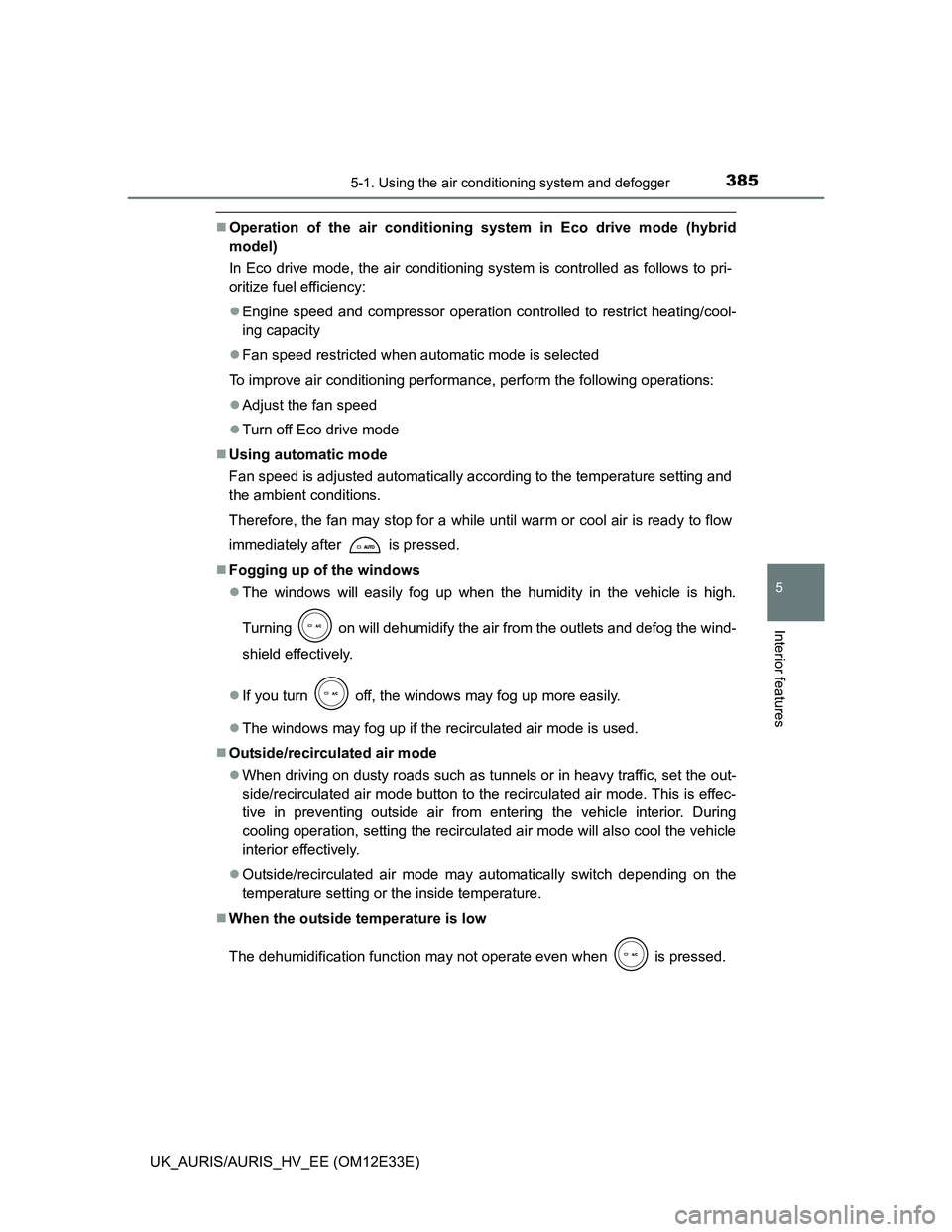
3855-1. Using the air conditioning system and defogger
UK_AURIS/AURIS_HV_EE (OM12E33E)
5
Interior features
Operation of the air conditioning system in Eco drive mode (hybrid
model)
In Eco drive mode, the air conditioning system is controlled as follows to pri-
oritize fuel efficiency:
Engine speed and compressor operation controlled to restrict heating/cool-
ing capacity
Fan speed restricted when automatic mode is selected
To improve air conditioning performance, perform the following operations:
Adjust the fan speed
Turn off Eco drive mode
Using automatic mode
Fan speed is adjusted automatically according to the temperature setting and
the ambient conditions.
Therefore, the fan may stop for a while until warm or cool air is ready to flow
immediately after is pressed.
Fogging up of the windows
The windows will easily fog up when the humidity in the vehicle is high.
Turning on will dehumidify the air from the outlets and defog the wind-
shield effectively.
If you turn off, the windows may fog up more easily.
The windows may fog up if the recirculated air mode is used.
Outside/recirculated air mode
When driving on dusty roads such as tunnels or in heavy traffic, set the out-
side/recirculated air mode button to the recirculated air mode. This is effec-
tive in preventing outside air from entering the vehicle interior. During
cooling operation, setting the recirculated air mode will also cool the vehicle
interior effectively.
Outside/recirculated air mode may automatically switch depending on the
temperature setting or the inside temperature.
When the outside temperature is low
The dehumidification function may not operate even when is pressed.
Page 395 of 750
3935-1. Using the air conditioning system and defogger
UK_AURIS/AURIS_HV_EE (OM12E33E)
5
Interior features
Front side outlets
Direct air flow to the left or right,
up or down.
Open the vent
Close the vent
Operation of the air conditioning system in Eco drive mode (hybrid
model)
In Eco drive mode, the air conditioning system is controlled as follows to pri-
oritize fuel efficiency:
Engine speed and compressor operation controlled to restrict heating/cool-
ing capacity
Fan speed restricted when automatic mode is selected
To improve air conditioning performance, perform the following operations:
Adjust the fan speed
Turn off Eco drive mode
Using automatic mode
Fan speed is adjusted automatically according to the temperature setting and
the ambient conditions.
Therefore, the fan may stop for a while until warm or cool air is ready to flow
immediately after is pressed.
1
2
Page 398 of 750
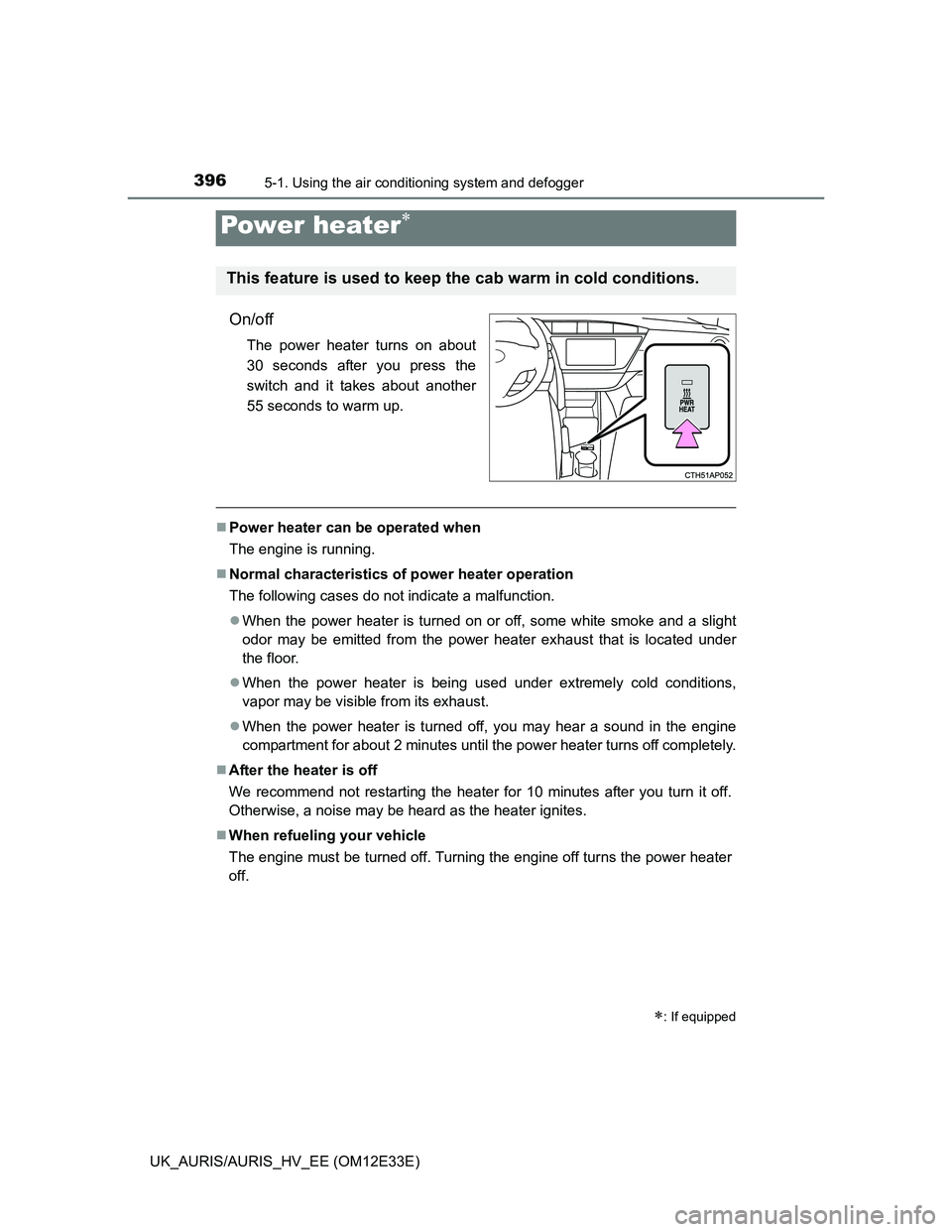
3965-1. Using the air conditioning system and defogger
UK_AURIS/AURIS_HV_EE (OM12E33E)
On/off
The power heater turns on about
30 seconds after you press the
switch and it takes about another
55 seconds to warm up.
Power heater can be operated when
The engine is running.
Normal characteristics of power heater operation
The following cases do not indicate a malfunction.
When the power heater is turned on or off, some white smoke and a slight
odor may be emitted from the power heater exhaust that is located under
the floor.
When the power heater is being used under extremely cold conditions,
vapor may be visible from its exhaust.
When the power heater is turned off, you may hear a sound in the engine
compartment for about 2 minutes until the power heater turns off completely.
After the heater is off
We recommend not restarting the heater for 10 minutes after you turn it off.
Otherwise, a noise may be heard as the heater ignites.
When refueling your vehicle
The engine must be turned off. Turning the engine off turns the power heater
off.
Power heater
: If equipped
This feature is used to keep the cab warm in cold conditions.
Page 399 of 750
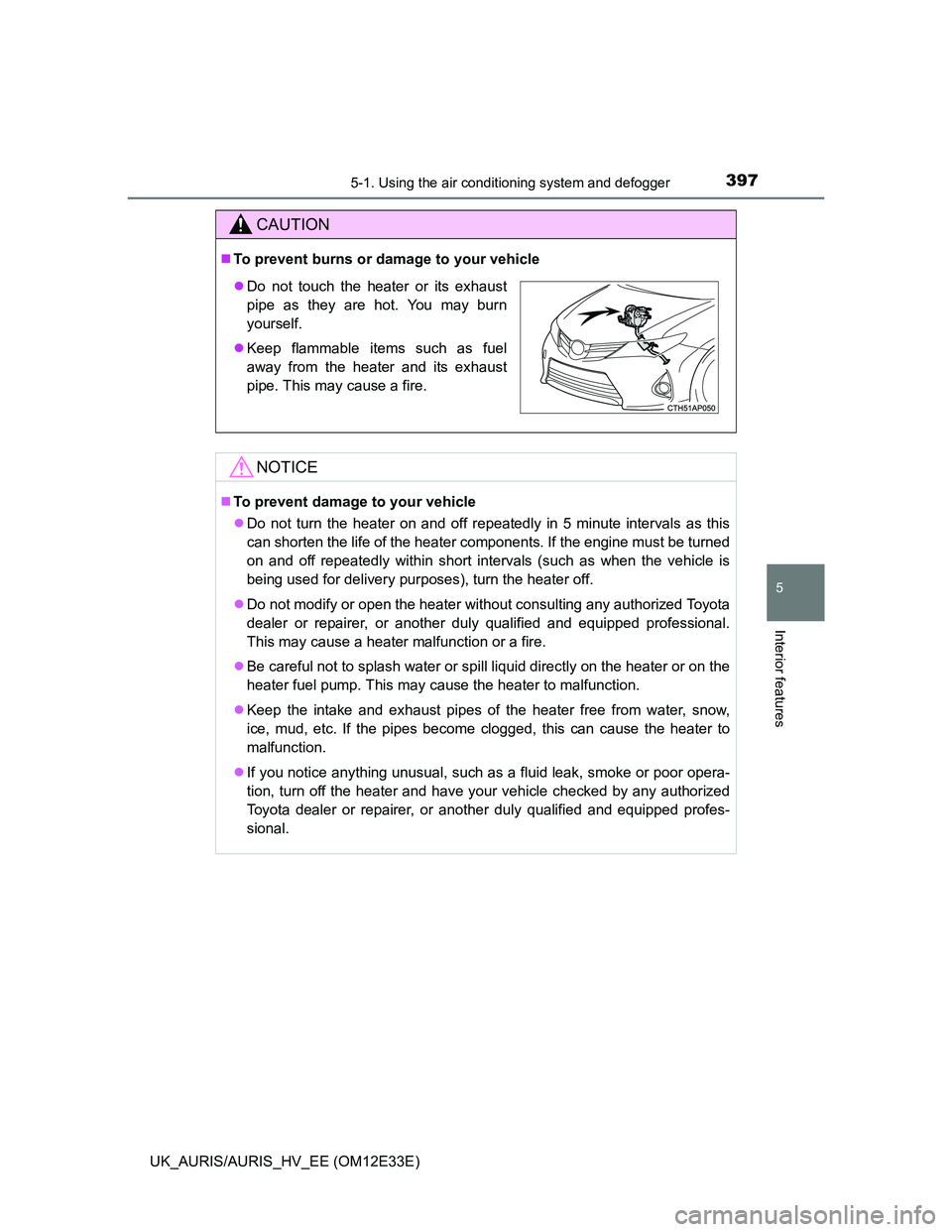
3975-1. Using the air conditioning system and defogger
UK_AURIS/AURIS_HV_EE (OM12E33E)
5
Interior features
CAUTION
To prevent burns or damage to your vehicle
NOTICE
To prevent damage to your vehicle
Do not turn the heater on and off repeatedly in 5 minute intervals as this
can shorten the life of the heater components. If the engine must be turned
on and off repeatedly within short intervals (such as when the vehicle is
being used for delivery purposes), turn the heater off.
Do not modify or open the heater without consulting any authorized Toyota
dealer or repairer, or another duly qualified and equipped professional.
This may cause a heater malfunction or a fire.
Be careful not to splash water or spill liquid directly on the heater or on the
heater fuel pump. This may cause the heater to malfunction.
Keep the intake and exhaust pipes of the heater free from water, snow,
ice, mud, etc. If the pipes become clogged, this can cause the heater to
malfunction.
If you notice anything unusual, such as a fluid leak, smoke or poor opera-
tion, turn off the heater and have your vehicle checked by any authorized
Toyota dealer or repairer, or another duly qualified and equipped profes-
sional.
Do not touch the heater or its exhaust
pipe as they are hot. You may burn
yourself.
Keep flammable items such as fuel
away from the heater and its exhaust
pipe. This may cause a fire.
Page 476 of 750
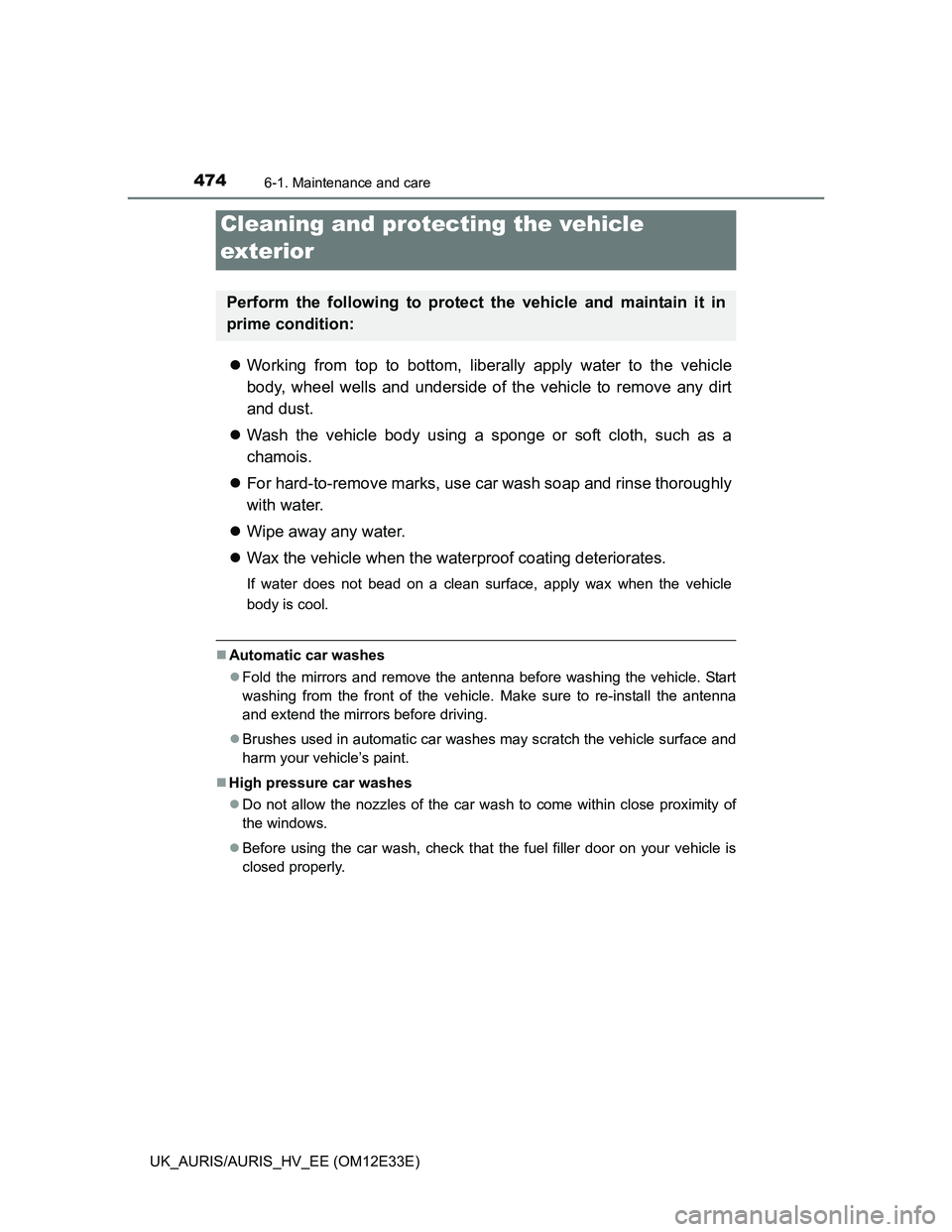
474
UK_AURIS/AURIS_HV_EE (OM12E33E)
6-1. Maintenance and care
Working from top to bottom, liberally apply water to the vehicle
body, wheel wells and underside of the vehicle to remove any dirt
and dust.
Wash the vehicle body using a sponge or soft cloth, such as a
chamois.
For hard-to-remove marks, use car wash soap and rinse thoroughly
with water.
Wipe away any water.
Wax the vehicle when the waterproof coating deteriorates.
If water does not bead on a clean surface, apply wax when the vehicle
body is cool.
Automatic car washes
Fold the mirrors and remove the antenna before washing the vehicle. Start
washing from the front of the vehicle. Make sure to re-install the antenna
and extend the mirrors before driving.
Brushes used in automatic car washes may scratch the vehicle surface and
harm your vehicle’s paint.
High pressure car washes
Do not allow the nozzles of the car wash to come within close proximity of
the windows.
Before using the car wash, check that the fuel filler door on your vehicle is
closed properly.
Cleaning and protecting the vehicle
exterior
Perform the following to protect the vehicle and maintain it in
prime condition:
Page 488 of 750
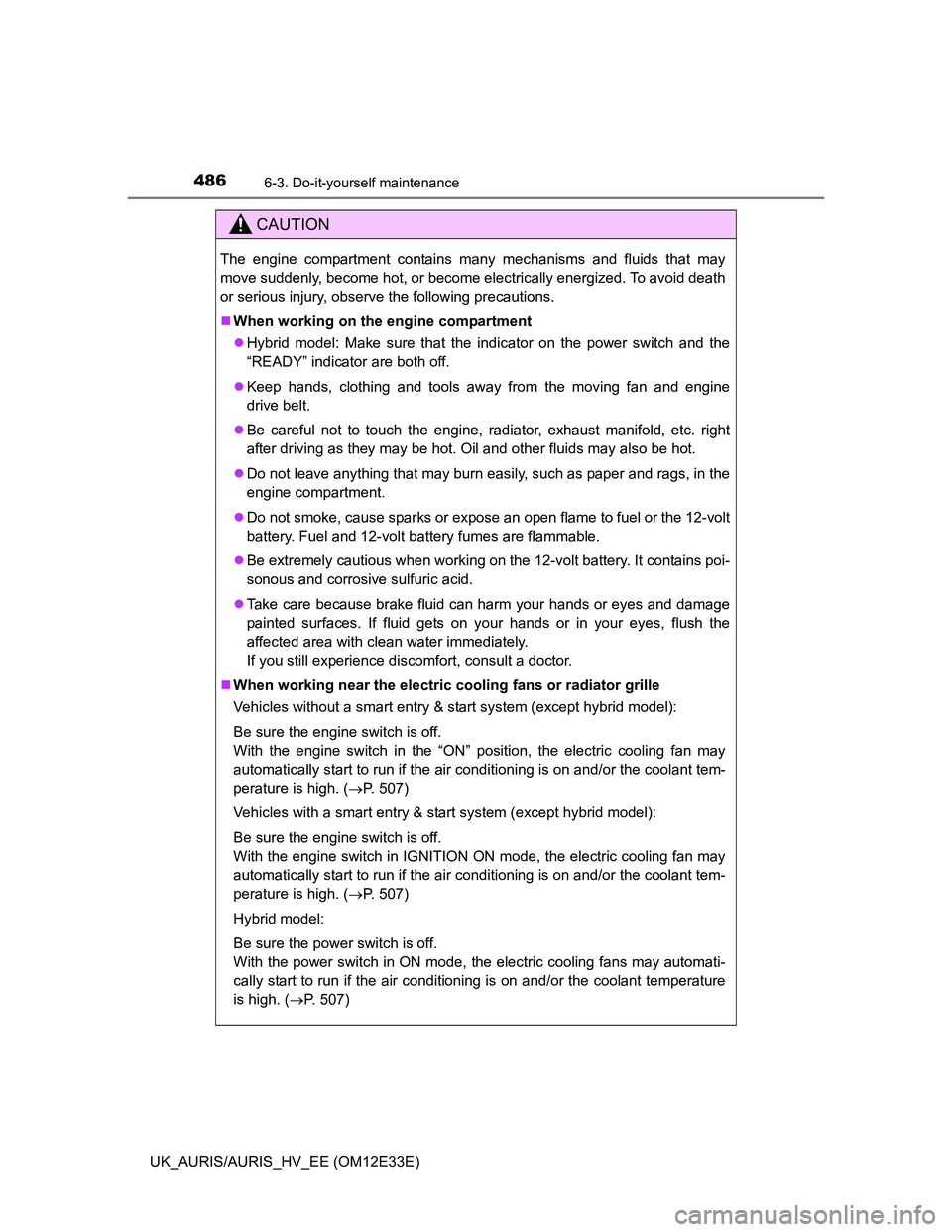
4866-3. Do-it-yourself maintenance
UK_AURIS/AURIS_HV_EE (OM12E33E)
CAUTION
The engine compartment contains many mechanisms and fluids that may
move suddenly, become hot, or become electrically energized. To avoid death
or serious injury, observe the following precautions.
When working on the engine compartment
Hybrid model: Make sure that the indicator on the power switch and the
“READY” indicator are both off.
Keep hands, clothing and tools away from the moving fan and engine
drive belt.
Be careful not to touch the engine, radiator, exhaust manifold, etc. right
after driving as they may be hot. Oil and other fluids may also be hot.
Do not leave anything that may burn easily, such as paper and rags, in the
engine compartment.
Do not smoke, cause sparks or expose an open flame to fuel or the 12-volt
battery. Fuel and 12-volt battery fumes are flammable.
Be extremely cautious when working on the 12-volt battery. It contains poi-
sonous and corrosive sulfuric acid.
Take care because brake fluid can harm your hands or eyes and damage
painted surfaces. If fluid gets on your hands or in your eyes, flush the
affected area with clean water immediately.
If you still experience discomfort, consult a doctor.
When working near the electric cooling fans or radiator grille
Vehicles without a smart entry & start system (except hybrid model):
Be sure the engine switch is off.
With the engine switch in the “ON” position, the electric cooling fan may
automatically start to run if the air conditioning is on and/or the coolant tem-
perature is high. (P. 507)
Vehicles with a smart entry & start system (except hybrid model):
Be sure the engine switch is off.
With the engine switch in IGNITION ON mode, the electric cooling fan may
automatically start to run if the air conditioning is on and/or the coolant tem-
perature is high. (P. 507)
Hybrid model:
Be sure the power switch is off.
With the power switch in ON mode, the electric cooling fans may automati-
cally start to run if the air conditioning is on and/or the coolant temperature
is high. (P. 507)
Page 496 of 750
4946-3. Do-it-yourself maintenance
UK_AURIS/AURIS_HV_EE (OM12E33E)
1ND-TV engine
Washer fluid tank (P. 5 11 )
Engine coolant reservoir
(P. 505)
Engine oil filler cap
(P. 501)
Engine oil level dipstick
(P. 497)Fuel filter (P. 512)
12-volt battery (P. 508)
Fuse box (P. 532)
Radiator (P. 507)
Electric cooling fan
Condenser (P. 507)
Intercooler (P. 507)1
2
3
4
5
6
7
8
9
10
11